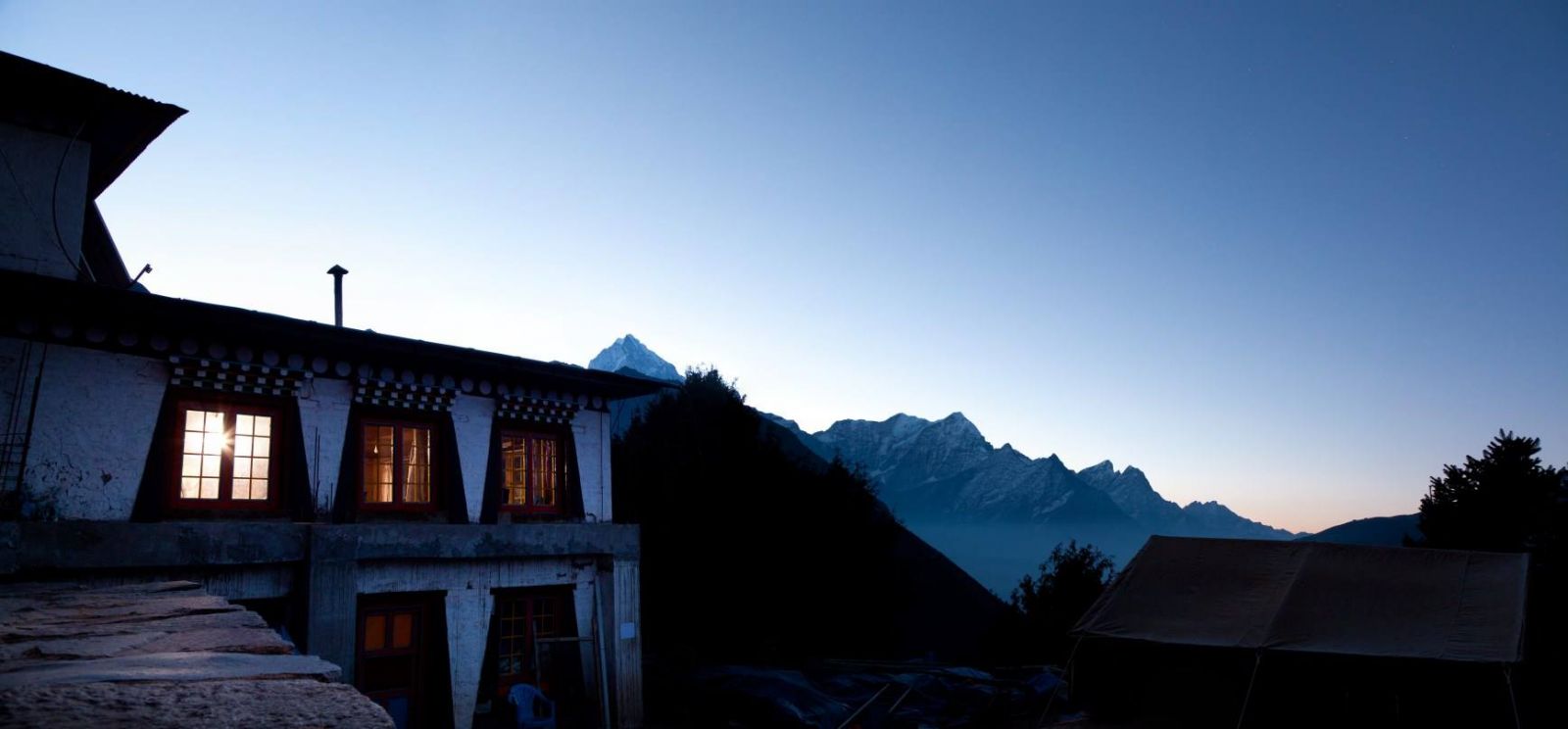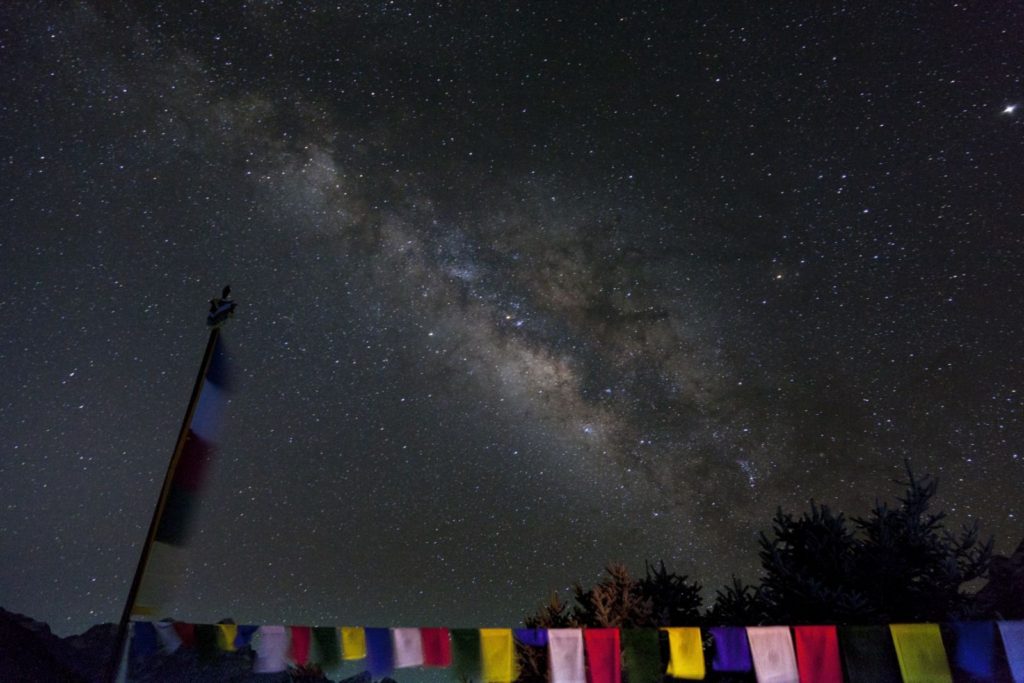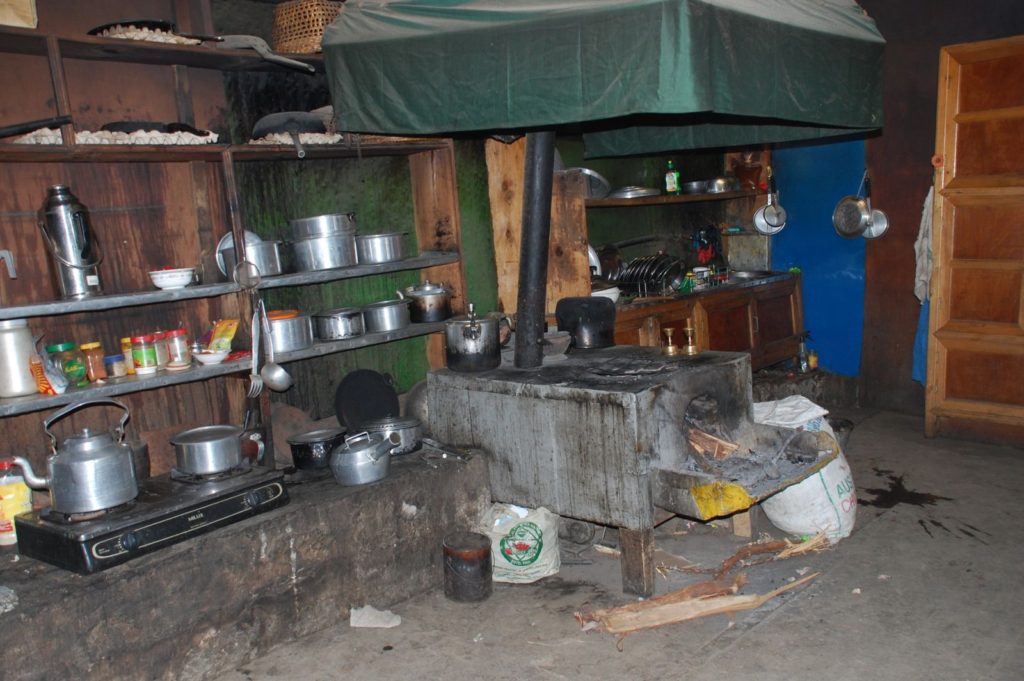
Planned improvements at Lawudo Retreat Center
Three issues that have an enormous impact on livability at Lawudo, Lama Zopa Rinpoche’s retreat center 4,200 meters above sea level near Namche Bazaar in Nepal, are water, electricity, and cooking – and they are inextricably linked. A fourth, toilets, affects the comfort of the older residents of Lawudo and the visitors who come to retreat year-round.
Participants in the 2018 Lawudo Trek, organized by The Bodhichtta Trust, were inspired to help solve these problems. At Lawudo in March, Doug Kirkpatrick, MaryEllen Kirkpatrick (click here to read MaryEllen’s latest report from Kathmandu), andScott Johnston analyzed the problems and discussed solutions with Sangay Sherpa, Lawudo’s director. Amber Tamang in Kathmandu has also provided advice.

MaryEllen Kirkpatrick estimates costs at around US$24,050 (see Cost Analysis, below).
So far, the Lawudo Trek has offered $2,500, Doug Kirkpatrick has offered $4,000, and Ven. Lozang Gyurme has offered $7,300.
The Bodhichita Trust will underwrite the projects while raising the balance of the funds, $10,250.
MaryEllen Kirkpatrick has kindly agreed to take on the management of the projects and will arrive in Kathmandu on September 13. She estimates she can complete the work by early 2019.
She is well qualified. She has experience in the upkeep, repairs and improvements to old buildings and has skills in rough carpentry, basic plumbing and fundamental electrical work.
She has designed and installed rooftop rainwater harvesting systems, built fences using wood and hand-mixed concrete, and has designed and built a number of structures.
As the general manager of a reconstruction project, she hired and supervised construction and finishing crews. She has also taught young men how to safely use a wide variety of hand- and power-tools.
She has served for many years as a chef. She has experience in cooking on wood-fired iron stoves and is familiar with the issues of getting a hearth fire and a stove to draft properly.
This video tells the story of recent upgrade projects at the Lawudo Gompa and Retreat Center.
UPDATE December, 2018. After three months of research here are MaryEllen Kirkpatrick’s findings and proposals:
1. WATER
The water at Lawudo comes from a little stream about 2 kilometers up the mountain. It runs downhill for about a kilometer, gravity-fed through a roughly 2-inch diameter black rubber tube, to an intermediate poly storage tank. This tank is equipped with two pumps that then move the water slightly up-hill for an additional kilometer, eventually reaching the retreat center. This is currently the only water that Lawudo has access to.

The night sky at Lawudo, March 2018. Photo Scott Johnston.
There is a project in the works, a joint effort by the Nepalese government and several local communities, to build 5 to 7 kilometers of pipeline from a lake in the mountains above Lawudo to supply water to communities below. Sangay Sherpa-la estimates that Lawudo’s share is $12–15,000. This would certainly solve the water problems at Lawudo.
However, this project is still in the initial planning stages and the pipeline is not likely to be running until 2020, more or less. Meanwhile, to bring 50 percent more water to Lawudo immediately, we will install an off-grid Solar Water Pumping System designed for Lawudo by Gham Power Nepal, which will power the pumps with energy generated by the solar cells and stored in batteries installed at the site of the intermediate tank and pumps.
2. ELECTRICITY
The pumps that are connected to the current water storage tank are powered by 230volts AC on a copper wire line coming from Lawudo two kilometers away. They draw 6.5 amps each, 13 amps in total, at 230VAC, which is 3kw of power.
The losses in the line and the extra current pulled by the drop in voltage when the pumps turn on represents more than half of Lawudo’s total electrical capacity.
Because of the reduced voltage, the pumps draw more current and thus operate at reduced efficiency. When the pumps come on after dark, all the lights at Lawudo dim or go out and the electric burners in the kitchen cease to function until the pumps turn off.
The installation of the Solar Water Pumping System will therefore also increase the availability of electricity for general use at Lawudo.
To increase the availability of electricity even more we plan to install a Solar Power Generating System, grid-tied, which will generate and store energy from solar panels to be installed on the roof of the library or some other south-southwest-facing area with a clear line of elevation.
This system will allow Lawudo to more efficiently smooth out its peak power draws against the hard cap of 8.5kW of power presently allocated to Lawudo by the Nepal electricity authorities.
3. COOKING
The old stove used now at Lawudo for cooking and heating generates excessive smoke in the kitchen because it leaks and does not vent properly.
We will replace the old stove with a more efficient, smokeless, industrial stove from the Himalayan Stove Project. This will be delivered to Kathmandu in January, 2019.
This model of stove is currently being used in more than 50 locations in Nepal, particularly in the areas that were severely impacted by the earthquake in 2015. The Himalayan Stove Project’s smaller, family-sized stove is currently widely in use in all regions of Nepal.
We will make adjustments to the stovepipe to increase the draft from the current stove and thus reduce the smoke while we await the installation of the new stove.
We will install two inductive cooking burners in the kitchen to augment and replace the old electric coil burners that are used for boiling water now.
We will provide the carbon steel, iron and magnetic metal cook pots, woks and a kettle suitable for this type of burner.

The current stove in the Lawudo kitchen. Photo MaryEllen Kirkpatrick.
4. TOILETS
We will provide portable toilets with basins fitted below – one for Lama Zopa Rinpoche’s personal use and two for the old or sick.
We are working with a Kathmandu company manufacture pedestals with standard toilet seats to be fitted above six of the squat toilets at Lawudo, making them more comfortable for the visiting retreaters.
Lawudo Projects Cost Analysis
*All amounts in USD
1. WATER
Solar Water Pumping System
Gham Power Nepal
9 solar panels @ $190 each: $1,710
12 solar tubular batteries @ $340 each: $4,080
1 power inverter to convert DC electricity generated in solar cells and stored in the batteries to AC power accessible the water pumps: $1,490
1 aluminium support structure: $225
1 set of materials, including cables, MC4 connectors, MCBs, conduit, wiring, etc.: $240
Installation: $195
13% VAT on $6,230 (all except solar panels): $810
TOTAL $8,750
2. ELECTRICITY
Solar Power Generating System
Gham Power Nepal
Currently being designed: estimate $9,000
3. COOKING
New stove, induction cooking, pots, etc. to be bought in Kathmandu
1 industrial stove by Himalayan Stove Project for delivery to Kathmandu January, 2019: $1,000
1 stovepipe extension: $50
2 induction cooking surfaces @ $75 each: $150
1 set of 2 pots, 2 woks, 1 kettle: $200
TOTAL $1,400
4. TOILETS
1 portable toilet for Lama Zopa Rinpoche: $60
2 portable toilets @ $50: $100
6 toilet pedestals and seating for squat toilets @ $40: $240
TOTAL $400
5. PORTERS TO LAWUDO
Estimate $500
6. MANAGEMENT
MaryEllen Kirkpatrick’s airfares SFO-KTM-SFO; KTM-LUA; board and keep for four months $4,000
TOTAL ESTIMATED EXPENSES $24,050
Less Lawudo Trek’s $2,500
Less Doug Kirkpatrick’s $4,000
Less Ven. Lozang Gyurme’s $7,300
